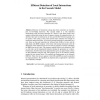Free Online Productivity Tools
i2Speak
i2Symbol
i2OCR
iTex2Img
iWeb2Print
iWeb2Shot
i2Type
iPdf2Split
iPdf2Merge
i2Bopomofo
i2Arabic
i2Style
i2Image
i2PDF
iLatex2Rtf
Sci2ools
PAKDD
2000
ACM
2000
ACM
Efficient Detection of Local Interactions in the Cascade Model
Detection of interactions among data items constitutes an essential part of knowledge discovery. The cascade model is a rule induction methodology using levelwise expansion of a lattice. It can detect positive and negative interactions using the sum of squares criterion for categorical data. An attribute-value pair is expressed as an item, and the BSS (between-groups sum of squares) value along a link in the itemset lattice indicates the strength of interaction among item pairs. A link with a strong interaction is represented as a rule. Items on the node constitute the left-hand side (LHS) of a rule, and the right-hand side (RHS) displays veiled items with strong interactions with the added item. This implies that we do not need to generate an itemset containing the RHS items to get a rule. This property enables effective rule induction. That is, rule links can be dynamically detected during the generation of a lattice. Furthermore, the BSS value of the added attribute gives an upper b...
Related Content
| Added | 25 Aug 2010 |
| Updated | 25 Aug 2010 |
| Type | Conference |
| Year | 2000 |
| Where | PAKDD |
| Authors | Takashi Okada |
Comments (0)

